Class 10th Science - Our Environment Case Study Questions and Answers 2022 - 2023
By QB365 on 09 Sep, 2022
QB365 provides a detailed and simple solution for every Possible Case Study Questions in Class 10 Science Subject - Our Environment, CBSE. It will help Students to get more practice questions, Students can Practice these question papers in addition to score best marks.
QB365 - Question Bank Software
Our Environment Case Study Questions With Answer Key
10th Standard CBSE
-
Reg.No. :
Science
-
Advancement of the technology has resulted in improvement of our lifestyle and has also changed our attitude. When the human population was low and technology was in its infancy, the various kinds of solid wastes generated due to human activities were easily degraded by decomposers present in nature and it did not create any Significant harmful effect on the environment. In the recent times, however human population has increased tremendously and the technology has become greatly advanced. These two factors have contributed Significantly in the deterioration of our environment due to addition of number of wastes.
(i) Samaira took three different types of solid wastes P,Q, R and buried them under the soil in a pot, as she wanted to study their rate of decomposition. Her findings are shown in the given graph
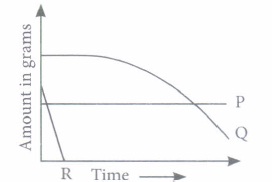
Select the option that correctly identifies P, Q and RP Q R (a) Polythene bag Leather bag Fruit peel (b) Used syringes Broken glass Leather purse (c) Cardboard Cow dung Rubber mat (d) Human excreta Paper cup Cow dung (ii) Which of the following statements regarding solid wastes is correct?
(a) Change in the packaging technology has resulted in generation of lot of solid wastes.
(b) Dumping of solid wastes could reduce the fertility of the soil leading to reduction in crop yield.
(c) Accumulation of solid waste could cause increased incidents of disease in a locality.
(d) All of these
(iii) Teacher kept few solid wastes in her class as givenJute bag (I), Tube light (II), Aluminium (oil (III), Paper cup (IV), Fruits (V), Glass tumbler (VI), Hedge trimming (VII), Plastic bag (VIII), Metal keys (IX), DDT (X) She asked students to arrange them in group A (Biodegradable) and group B (Non-biodegradable). Select the student that has grouped the items correctly.
(a) Tarun - Group A: I, IV, V,VII, Group B : II, III, VI, VIII, IX, X (b) Shivani - Group A : I, III, V,VII, X Group B : II, IV, VI, VIII, IX (c) Neha - Group A: II, III, IV, V, IX Group A: II, III, IV, V, IX (d) Advait - Group A : I, III, IV, V,X Group B : II, VI, VII, VIII, IX (iv) Select the option that incorrectly matches the type of solid waste and its correct disposal system
(a) Plastic bottle - Send for recycling
(b) Used tea leaves and kitchen waste - Collect in a pit to form compost
(c) Used syringes and needle - Wash and reused
(d) Municipal solid waste and fecal sludge - Buried in low lying areas to level uneven surface of land
(v) Given graph shows time taken by different types of materials to decompose.
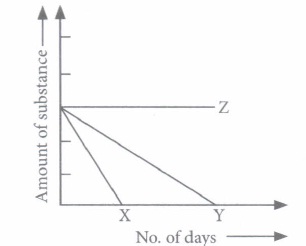
Which of the following substances could be anon-biodegradable material?(a) X (b) Y (c) Z (d) None of these (a) -
In any given ecosystem, all living organisms are linked in a systematic chain with respect to their mode of manufacturing food/feeding habits. This sequential interlinking of organisms involving transfer of food energy from producers through a series of organisms with repeated eating and being eaten is called the food chain. A food chain may have 3-4 trophic levels.
(i) Which of the following statements regarding food chain is incorrect?
(a) It is a single straight pathway through which food energy travels in the ecosystem.
(b) It adds adaptability and competitiveness to the organisms.
(c) Presence of isolated food chains adds to instability of the ecosystem.
(d) Food chain binds up inorganic nutrients of the ecosystem.
(ii) Consider the following food chain.
Grass \(\longrightarrow\)A \(\longrightarrow\)Frog \(\longrightarrow\) Snake\(\longrightarrow\)Eagle
Which of the following can be placed at A?(a) Grasshopper (b) Rabbit (c) Phytoplankton (d) Rat (iii) Select the correct food chain.
(a) Aquatic plants \(\longrightarrow\) Tadpole \(\longrightarrow\)Water beetle\(\longrightarrow\)Pike\(\longrightarrow\)Perch
(b) Grass\(\longrightarrow\)Grasshopper\(\longrightarrow\)Snake\(\longrightarrow\) Frog\(\longrightarrow\) Eagle
(c) Grass\(\longrightarrow\) Rabbit\(\longrightarrow\) Wild cat\(\longrightarrow\) Tiger
(d) Zooplankton \(\longrightarrow\) Phytoplankton \(\longrightarrow\)Small fish\(\longrightarrow\)Fish
(iv) Food chains are sustained by producers and _____________.(a) herbivores (b) carnivores (c) omnivores (d) decomposers (v) Select the incorrect statement.
(a) Food chain may terminate at level of herbivore
(b) Food chain is always straight
(c) Food chain may have 3-5 trophic levels
(d) In a food chain, 80 to 90% of potential energy is lost as heat, at each transfer(a) -
Alternatives are always available in nature which results in a sort of interlocking pattern or food web. For instance, if a particular species of producers get destroyed by a disease in an ecosystem, herbivores of that area can feed on other species. Also in a food web, any given species may operate simultaneously at more than one trophic level
(i) Refer to the given food web.
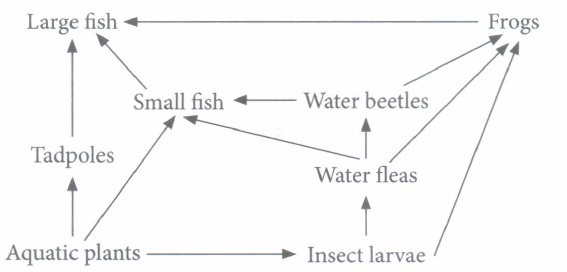
What will be the effect on the food web if population of water fleas get eliminated?
(a) Population of water beetles will increase.
(b) Population of insect larvae will remain unaffected.
(c) Population of small fish will decrease.
(d) Population of frog will increase.
(ii) In the given food web, which organism operates at both primary and tertiary consumer level?(a) Small fish (b) Frog (c) Water fleas (d) Tadpole (iii) Refer to the given food web.
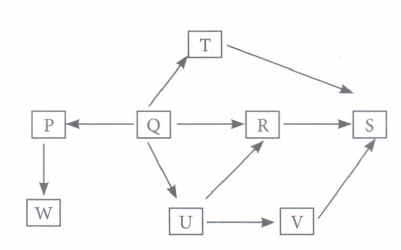
Which of the following statement the given food web is correct?
(a) When population of U decreases, population of R ants regarding nd V will increase.
(b) When population of Q decreases, population of R, T and U will increase.
(c) When population of R increases, population of S will increase.
(d) When population of S increases, population of R, T and U will also increase.
(iv) Which of the following statements is correct?
(a) Food webs provide alternative pathways of food availability.
(b) Greater alternatives available in a food web make the ecosystem more stable.
(c) Food webs also help in ecosystem development.
(d) All of these
(v) Food webs make a natural ecosystem ____________ than an man-made ecosystem(a) unstable (b) stable (c) variable (d) inconsistent (a) -
Some harmful non-biodegradable chemicals, i.e., pesticides (e.g., DDT) and heavy metals (e.g., mercury, arsenic cadmium, etc.) enter the bodies of organism through the food chain and go on concentrating at each trophic level. This phenomenon is called bio-magnification or biological magnification.
(i) Refer to the given food chain
Phytoplankton \(\longrightarrow\) Zooplankton \(\longrightarrow\)Small fish \(\longrightarrow\) Large fish\(\longrightarrow\)Fish eating birds
If concentration of DDT in small fish is estimated to be 0.5 ppm, then amount of DDT in zooplankton and large fish would respectively be(a) 0.04 ppm, 2ppm (b) 2 ppm, 0.04 ppm (c) 0.04 ppm, 0.04 ppm (d) 2 ppm, 0.5 ppm. (ii) Refer to the given table.
Organism Amount of cadmium A 0.5 ppm B 25ppm C 0.003 ppb D 2ppm E 0.04ppm According to the given data. The correct order in a food chain will be
(a) E\(\rightarrow\)C\(\rightarrow\)D\(\rightarrow\)A\(\rightarrow\)B (b) B\(\rightarrow\)D\(\rightarrow\)A\(\rightarrow\)E\(\rightarrow\)C (c) C\(\rightarrow\)E\(\rightarrow\)A\(\rightarrow\)D\(\rightarrow\)B (d) C\(\rightarrow\)E\(\rightarrow\)A\(\rightarrow\)B\(\rightarrow\)D (iii) A group of scientists analysed samples of five different animals from a river for possible accumulation of DDT in their body due to bio-magnification. The result obtained is shown in the given graph.
The correct order of the food chain operating in a river is
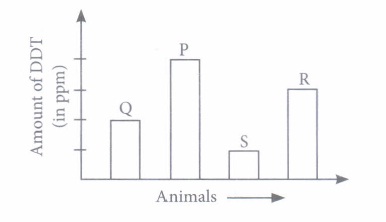
(a) S\(\rightarrow\)P\(\rightarrow\)Q\(\rightarrow\)R (b) S\(\rightarrow\)Q\(\rightarrow\)R\(\rightarrow\)P (c) P\(\rightarrow\)R\(\rightarrow\)Q\(\rightarrow\)S (d) P\(\rightarrow\)Q\(\rightarrow\)S\(\rightarrow\)R (iv) Higher amount of DDT disturb calcium metabolism of birds. This results in
(a) thickening of their egg shells (b) premature breaking of eggs (c) death of their embryos (d) both (b) and (c) (v) When animals are sprayed with poisons, they may die immediately, but their bodies still contain the poison. The poison in their bodies will then be passed on to the animals which eat them. What would be the consequence of a mass poisoning of the rabbit population in a grazing food chain and why?
(a) Plants would die quickly as they are eaten by rabbits
(b) Grasshopper would die quickly as all the animals in the food web would be affected
(c) Western rattlesnakes would quickly become poisoned as they eat rabbits
(d) Hawk would become poisoned as they feed on rabbits(a) -
Ozone layer is present in the earth's atmosphere. It is in the form of a protective shield. It contains three oxygen atoms (O3) which are formed as a consequence of photochemical reactions in the environment. Ozone absorbs harmful ultraviolet radiations of the sun. In this way, it protects all living beings on the earth. The thinning of ozone layer due to various human activities allows more UV radiations to pass through it which leads to harmful effects on man, animals and plants.
(i) Ozone layer is present in which layer of the atmosphere?(a) Troposphere (b) Mesosphere (c) Stratosphere (d) Thermosphere (ii) Enhanced UV-radiations would affect humans and other animals causing
(a) skin cancer
(b) blindness and increased chances of cataract in eyes
(c) malfunctioning of the immune system
(d) all of these
(iii) Read the given statements regarding ozone.
I. Ozone hole was first discovered over Montreal in 1976.
II. Ozone is a result of photochemical reactions in which starting molecule is oxygen.
III. Harmful chemicals produce active chlorine in presence of UV radiations, that destroys ozone layers.
IV. Ozone absorbs UV-radiations in the range of 800 - 1100 A.
Select the option that correctly identifies them as true (T) and false (F).I II III IV (a) F T T F (a) F F T T (c) T T F F (d) T F T T (iv) Which of the following are related to depletion of ozone layer?
(a) Chlorofluorocarbons (b) Halons (c) Carbon tetrachloride (d) All of these (v) Refer to the given events regarding thinning of ozone layer and arrange them in a sequence.
I. Active chlorine is produced in presence of UV radiations.
II. CFCs are released in the air.
III. Ozone layer in the stratosphere become thin.
IV. CFCs enter from troposphere into stratosphere.
V. Use of CFCs in refrigerators and air conditioners as coolants.
VI. Active chlorine destroy ozone by converting it into oxygen.(a) V \(\rightarrow\) II \(\rightarrow\) I \(\rightarrow\) VI\(\rightarrow\)IV \(\rightarrow\) III (b) V \(\rightarrow\) II \(\rightarrow\) IV \(\rightarrow\)I \(\rightarrow\)VI \(\rightarrow\) III (c) V\(\rightarrow\) I \(\rightarrow\) II \(\rightarrow\) III\(\rightarrow\)VI \(\rightarrow\) IV (d) V \(\rightarrow\) IV\(\rightarrow\) II \(\rightarrow\)I \(\rightarrow\) III \(\rightarrow\) VI (a) -
Various steps of a food chain can be represented sequence wise with producers at base, herbivores above them, followed by primary carnivores and finally the top carnivore at the top. This graphic representation of ecological parameters like number, biomass, energy at different trophic levels is called ecological pyramid. Different types of pyramids are pyramid of energy, pyramid of biomass and pyramid of number.
(i) Refer to the given figure where various trophic levels are represented as P, Q, Rand S. At which level is maximum and minimum energy available respectively?
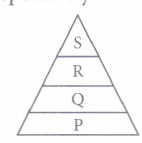
(a) P, S (b) S, P (c) P, R (d) Q, S (ii) On the basis of your knowledge, select the pyramid of biomass operating in a grassland ecosystem




(iii) Which of the following food chains is most likely represented by the given pyramid of number?

(a) Tree \(\rightarrow\) Aphid \(\rightarrow\) Lady bug - Bird \(\rightarrow\) Hawk
(b) Cyanobacteria \(\rightarrow\) Shrim\(\rightarrow\) Small fish \(\rightarrow\) Fish eating bird - Snake
(c) Plant\(\rightarrow\)Rat \(\rightarrow\)Snake \(\rightarrow\) Meerkat\(\rightarrow\)Lion
(d) Phytoplankton \(\rightarrow\) Zooplankton \(\rightarrow\)Shellfish\(\rightarrow\)Fish \(\rightarrow\)Shark
(iv) Which of the following pyramids is always upright?(a) Pyramid of number (b) Pyramid of biomass (c) Pyramid of energy (d) Both (a) and (c) (v) Refer to the given table
Trophic level Number of organisms Energy in trophic level (arbitrary units) W 100 10,000 X 1 100 Y 1000 100,000 Z 10 1000 Which of the following food chains is correct regarding the given data?
(a) W \(\rightarrow\) X\(\rightarrow\) Y \(\rightarrow\) Z (b) Y\(\rightarrow\) W \(\rightarrow\) Z\(\rightarrow\) X (c) W \(\rightarrow\)Z \(\rightarrow\)X\(\rightarrow\) Y (d) Y\(\rightarrow\)X\(\rightarrow\) Z\(\rightarrow\)W
(a) -
Various components of an ecosystem maintain a balance in nature. Disturbance in any component of the environment cause an imbalance. One of the main environmental problem caused by human activities is global warming. Global warming is a phenomenon caused by the increasing concentration of greenhouse gases in the atmosphere resulting due to enhanced greenhouse effect.
(i) Refer to the given pie chart showing the contribution of different gases to global warming.
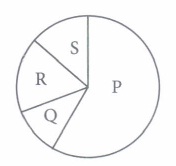
Identify gases P, Q, Rand S and select the incorrect statement regarding them.
(a) P could be a gas that increases in atmosphere due to excessive use of fossil fuel.
(b) Q could be a gas produced by complete combustion of biomass.
(c) R could be synthetic gaseous compounds used as refrigerants in air conditioners and refrigerators.
(d) S could be a gas produced by combustion of nitrogen rich fuel.
(ii) What could not be a source of gas Q given in the above pie chart?(a) Flooded paddy field (b) Cattle (c) Jet fuel (d) Marshes (iii) If there is no CO2 in the atmosphere, then what will be the most likely consequence of this on the temperature of earth?
(a) The temperature remain unchanged as it depends upon the oxygen content of the atmosphere.
(b) The temperature would increase as less greenhouse gases will be absorbed by CO2
(c) The temperature would decrease as CO2 is the principal greenhouse gas.
(d) None of these
(iv) Study carefully the following figure representing greenhouse effect.

Select the correct statement regarding this.
(a) Much of the long wavelength infrared radiations re-radiated by the earth's surface are absorbed by the atmospheric greenhouse gases.
(b) CO2 , CH4 , CFCs and N2O are the gases which are responsible for greenhouse effect.
(c) The atmosphere is transparent to the incoming short-wavelength radiations and is translucent to the long-wavelength infra-red radiations.
(d) All of these(v) Greenhouse effect is due to
(a) accumulation of O3 and depletion of CO2 (b) accumulation of both O3 and CO2 (c) accumulation of CO2 and depletion of O3 (d) presence of green plants on the earth (a) -
Disposal of waste should be done scientifically. Solid wastes, i.e., paper, plastics, metals, etc., can be recycled by sending them to respective recycling units. For instance, paper is sent for recycling into special paper mills; broken plastics, plastic bags, buckets, bowls, dishes, mugs, disks, etc.) are sent to plastic processing factories where these are melted and then remoulded; waste metals are sent to specific metal industries for recycling. Industrial wastes are treated in special plants where valuable wastes are recycled. Certain wastes are mixed to generate useful materials. For instance, molten plastic is mixed with asphalt and the material is used for making roads. Household waste, chemical waste and hospital waste are generally disposed off by an incineration process
(i) What does A represent in the given figure showing an incinerator?
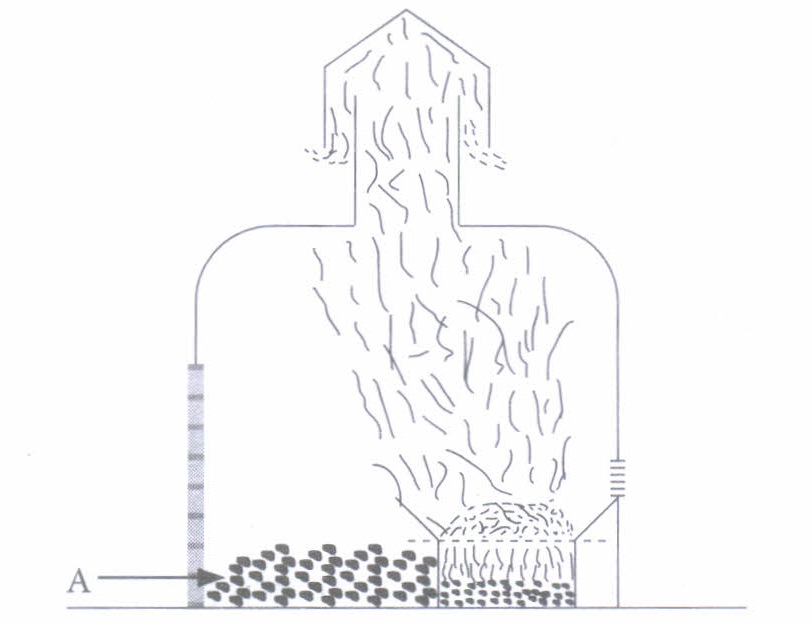
(a) Solid waste (b) Fire (c) Ash (d) None of these (ii) Which of the following statements regarding incineration is incorrect?
(a) It is the process of waste disposable by keeping waste at low temperature to stop enzymatic activity.
(b) Household waste, chemical waste and hospital waste are generally disposed by this method.
(c) Disposing waste by using this method generates carbon dioxide and water vapour.
(d) It involves aerobic burning of the combustible waste at high temperature
(iii) In the following groups of material which group contains only recyclable materials?
I. Wood, paper, fruit pulp
II. Plastic bottle, used aluminium foil, glass jug
III. Paper, metal key, plastic mug(a) I and II only (c) III only (b) II and III only (d) I, II and III (iv) Incineration and pyrolysis are two methods of waste disposal done at high temperature. The two differs from each other as in later
(a) aerobic burning occurs
(b) chemical energy and chemical constituents are the end products
(c) ashes are the end products
(d) medical wastes are burnt with clinkers as the end product.
(v) The committee members of Robin's society placed two bins-green coloured and blue coloured in their premises for collection of garbage.
Given is the list of few solid wastes generated in his societyPaper cup, credit card, fruit and vegetables peels, cardboard, metal rod, aluminium foil, plastic key chain, pencil, glass sheet Segregate the wastes in their respective bins and select the correct option.
Green bin Blue bin (a) Paper cup, credit card, pencil Fruit and vegetable peels, cardboard, metal rod, aluminium foil, plastic key chain, glass sheet (b) Paper cup, fruits and vegetables peels, cardboard, pencil Credit card, metal rod, aluminium foil, plastic key chain, glass sheet (c) Fruit and vegetables peels, cardboard, glass sheet,paper cup Credit card, metal rod, aluminium foil, plastic key chain, pencil (d) Credit card, metal rod, aluminium foil, glass sheet Paper cup, fruits and vegetables peels, cardboard, plastic key chain, pencil (a) -
A group of ecologists studied and monitored the change in population of three animal species X, Y and Z over a period of ten years. During their research, they found that a new animal species W appeared in the area and its population was also monitored.
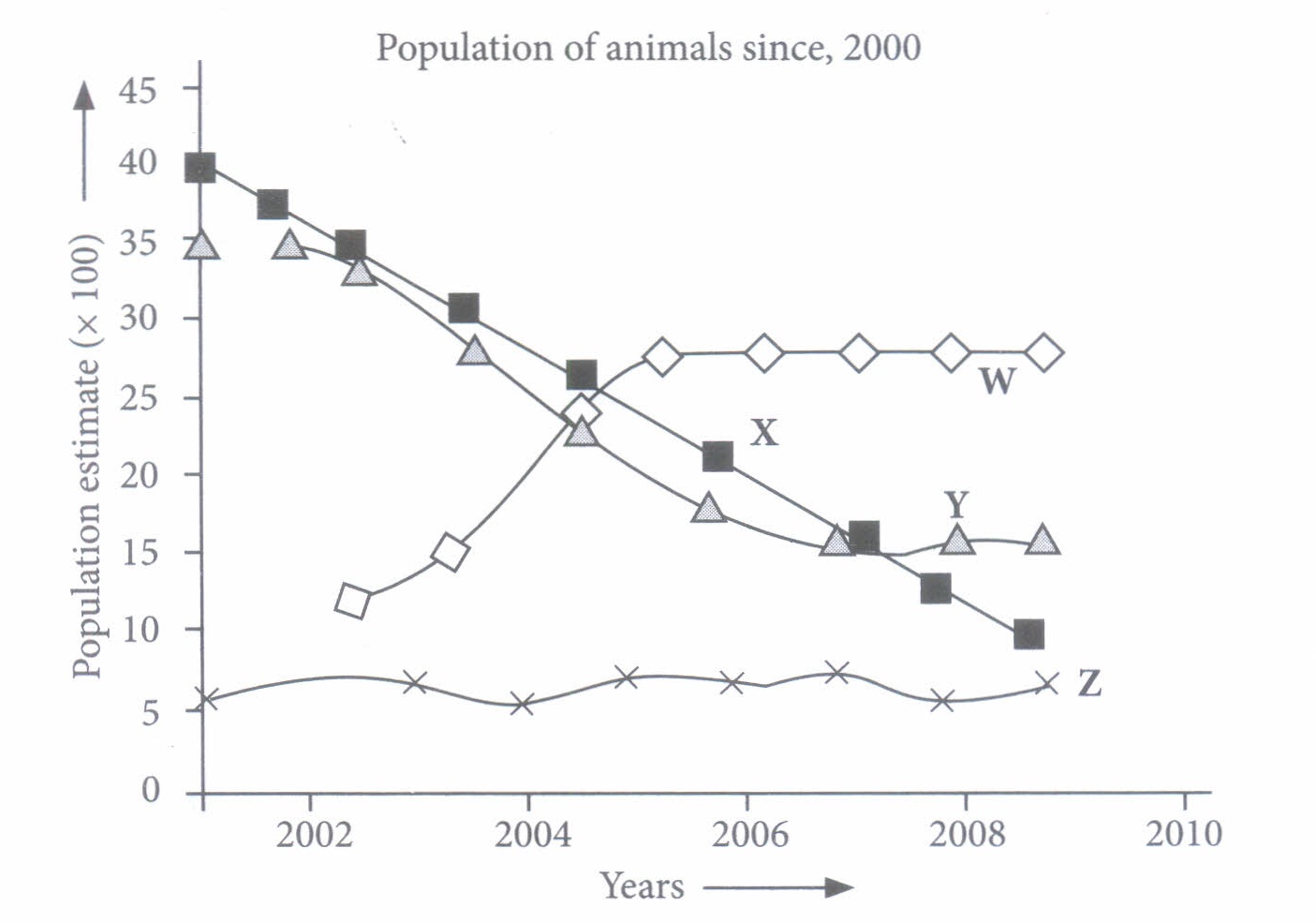
(I) Which animal species will unlikely to be alive in 10 years without some intervention?a) W (b) X (c) Y (d) Z (ii) Which of the following species is most likely be the food source of W?
(a) X (b) Y (c) Z (d) Both X and Z (iii) What will be the likely consequence if population of X completely declines?
(a) Populations of W, Y and Z also declines (b) Population of Y declines only. (c) Population of Z remains unchanged. (d) Population of Z increases. (iv) What would be the most probable reason for the constant population of Z?
(a) There is plenty of food available for Z.
(b) There is no predator of Z in the community.
(c) Ratio of death rate and birth rate is nearly equal in the population of Z.
(d) There is more number of preys for Z in the community.
(v) What could be the reason for declining of X?
(a) There could be more than one predator of X prevailing in the community.
(b) There is food scarcity for X.
(c) More number of prey species are present in the community for X.
(d) Both (a) and (b)(a) -
Food web is a network of food chains which become interconnected at various trophic levels so as to form a number of feeding connections amongst different organisms of a biotic community. Different food webs operate in different ecosystems. One such food web operating in an ecosystem is given ahead. Study it carefully and answer the following.
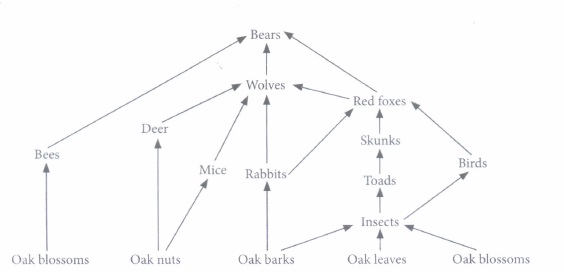
(i) What is the primary energy input in this food web?(a) Oak tree (b) Oak blossoms (c) Sunlight (d) Oak leaves (ii) How many food chains are operating in the given food web?
(a) 10 (b) 12 (c) 16 (d) 14 (iii) When a new species 'X' was introduced into the community, the population of toads rose and population of skunks fell over the subsequent two weeks. Species 'X' is most likely to be
(a) another herbivore like toad (b) a predator of insects only (b) a predator of insects only (d) a predator of skunks and prey of the toad (iv) Which of the following organisms in the food web passes most of its energy to the subsequent trophic levels?
(a) Bear (b) Wolf (c) Bee (d) Oak tree (v) Which organisms would be most affected if the oak tree fails to flower?
(a) Mice and insects (b) Birds and bees (c) Deer and mice (d) Insects and wolves (a) -
Energy flow is the key function of an ecosystem. It is determined by the two basic laws of thermodynamics. Flow of energy in our ecosystem is unidirectional. Green plants capture approximately about 1% of the solar energy incident on the earth to carry out the process of photosynthesis. In an ecosystem, transfer of energy follows 10 percent law, i.e., only 10% energy is transferred from one trophic level to another and remaining 90% of energy is lost in respiration.
(i) Read the given statements and select the incorrect one(s).
I. At each trophic level organisms utilise energy in respiration.
II. Only 10 percent of the solar radiations that fall on earth is used by green plants.
III. Green plants are the ultimate source of entire energy as most of the food chain begin with them.
IV. A food chain usually consist of 3-4 trophic levels.(a) I and II only (b) II and III only (c) IV only (d) I and III only (ii) Refer to the given flow chart.
Plants \(\rightarrow\) Rat \(\rightarrow\) Snake
20 units 2 units 0.2 unit
The given flow chart states that
(a) flow of energy in an ecosystem is unidirectional
(b) as we move along in a food chain the number of individuals at each trophic level decreases
(c) only 10% of the total energy becomes available to next trophic level
(d) both (a) and (c).
(iii) Nearly 90% of the energy is wasted while moving from one trophic level to other. This energy is used in(a) digestion of food (b) respiration (c) overcoming entropy (d) all of these. (iv) Refer to the given pyramid.
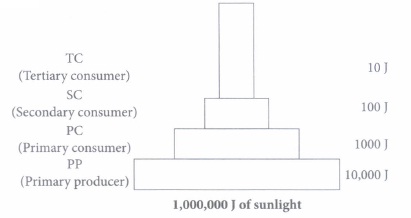
Which of the following best explains the phenomenon?(a) First law of thermodynamics (b) Second law of thermodynamics (c) Third law of thermodynamics (d) Both (a) and (b) (v) Which of the following correctly states the processes involved in energy transfer between the trophic levels?
Between the sun and producer Between producer and primary consumers Between primary and secondary consumers Feeding Photosynthesis Feeding Feeding Feeding Decomposition Photosynthesis Feeding Feeding Photosynthesis Feeding Decomposition (a) -
An ecosystem may be defined as a structural and functional unit of the biosphere comprising living organisms and their non-living environment which interact by means of food chains and biogeochemical cycles resulting in energy-flow, biotic diversity and material cycling to form a stable, self-supporting system.
(i) The two basic processes involved in an ecosystem are(a) cycling of materials and food chains (b) energy flow and self-sustainability (c) carbon cycle and biotic diversity (d) cycling of materials and flow of energy. (ii) Which among the following is not an artificial ecosystem?
a) Orchard (b) Lake (c) Aquarium (d) Cropland (iii) The role of fungi and bacteria in an ecosystem is to
(a) increase the supply of nutrients (b) increase the supply of energy (c) release nutrients from dead organic matter (d) increase the amount of CO2 in the atmosphere. (iv) What would one of the likely result if all decomposers in a particular ecosystem were wiped out?
(a) The atmospheric reservoir of carbon dioxide would decline.
(b) More food would be available for other consumers in the ecosystem.
(c) The other organisms in the ecosystem would experience lower death rates.
(d) There would be no significant impact, as dead organic matters would spontaneously decompose.
(v) Which of the following holds true for an ecosystem?
(a) Primary consumers are least dependent upon producers.
(b) Primary consumers most of the time out number producers.
(c) Organic substances such as carbon, nitrogen and oxygen constitute the main abiotic components.
(d) Permanent ecosystems are self-supporting natural ecosystems that maintain themselves for relatively long duration.(a) -
The various steps, representing organisms in a food chain, at which the transfer of food and energy takes place are called trophic levels. Trophic levels are mainly occupied by producers and consumers. Producers belong to the first trophic level while consumers occupy various trophic levels in a food chain. Consumers are heterotrophic organisms, that are of three types - herbivores, carnivores and decomposers. A simplified version of a food chain showing various trophic levels is represented as follows.

(i) T6 in the food chain is(a) decomposer (b) carnivore (c) herbivore (d) omnivore (ii) If T2 is occupied by grasshopper in a particular food chain, then T3 and T4 will most probably be
(a) bird, cow (b) man, elephant (c) frog, snake (d) snake, frog (iii) In an ecosystem, trophic levels are formed by
(a) herbivores only (b) carnivores only (c) omnivores only (d) organisms linked in a food chain (iv) Which of the following limits the number of trophic levels in a food chain?
(a) Decrease in energy at higher trophic levels (b) Deficient food supply (c) Polluted air (d) Water (v) Nitesh went to a garden. There he saw some sparrows eating worms from the green grass. After sometime suddenly an eagle attacked the bird and killed it. Which one among these organisms belong to trophic level 2 and 3 respectively in the food chain operating there?
(a) Worms, Sparrow (b) Sparrow, Eagle (c) Grass, Worms (d) Worms, Eagle (a) -
All living things need air to breathe. Contamination of air with particles, gases and chemicals that have the potential to adversely affect health of humans and animals, vegetation and human assets is called air pollution. Major air pollutants are S02, nitrogen oxides, CO, CFCs, etc. Refer to the given graph showing air quality of three cities
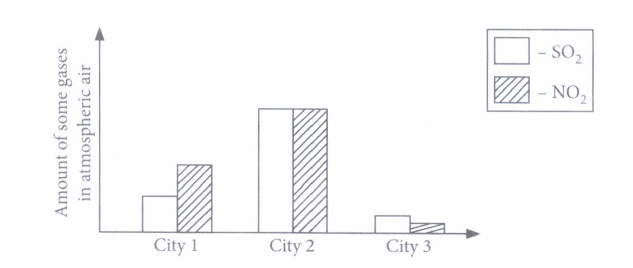
(i) What can be inferred from the given graph?
(a) Air of city 1,2 and 3 is free from pollution.
(b) Smog formed in city 3 is most intense and dangerous.
(c) Air of city 2 is most polluted. It could be due to excessive use of fossil fuels.
(d) City 1 is most likely to receive acidic precipitation, which is otherwise negligible in city 2 and city 3.
(ii) What will be the effect of high concentration of SO2 and NO2 in atmospheric air of city 2?
(a) Ozone layer over the city 2 will get affected.
(b) Temperature will be extremely high due to presence of these two gases in air.
(c) The oxides of sulphur and nitrogen react with rain water to produce acid rain.
(d) There will be an acceleration in photosynthetic activities of plants due to high availability of nitrogen in air.
(iii) Acid rain is one of the consequence of air pollution. Term acid rain was coined by(a) Robert Angus(a) Robert Angus (b) Odum (c) Tansley (d) Charles Elton (iv) Which of the following is the effect of acid rain?
(a) It damages the foliage thereby decreasing growth and yield of plants.
(b) Soil microbes get killed due to low pH of the soil and results in disturbing the terrestrial ecosystem.
(c) Building and monuments get damaged.
(d) All of these
(v) Oxides of nitrogen and sulphur are produced by the(a) respiration (b) combustion of fossil fuels (c) volcanic eruption (d) both (b) and (c). (a) -
Grazing food chains are directly dependent upon solar radiations as the primary source of energy. Green plants (or producers) form the first trophic level of the food chain. They synthesise their food by the process of photosynthesis. Herbivores or primary consumers feed upon the producers and form the second trophic level. Herbivores are eaten by carnivores of different categories. These are longer food chains. Given below are 5 grazing food chains operating in the nature.
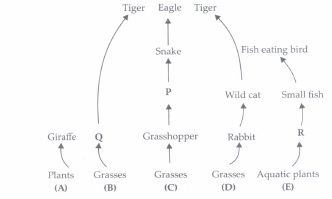
(i) Select the option that correctly identifies P, Q and R.P Q R (a) Frog Deer Aquatic insect (b) Frog Elephant Phytoplankton (c) Tadpole Deer Zooplankton .(d) Dog Elephant Algae (ii) According to the given food chains which of the following animals is both secondary and tertiary consumer?
(a) Rabbit (b) Tiger (c) Eagle (d) Small fish (iii) Top consumer in which of the following food chains will have the maximum energy?
(a) Food chain A (b) Food chain B (c) Food chain C (d) Food chain D (iv) If energy present in producers of food chain D is 20,000 KJ. Then amount of energy present in its secondary consumer will be
(a) 2000 KJ (b) 20 KJ (c) 2 KJ (d) 200 KJ (v) What will be the shape of pyramid of biomass of food chain E?
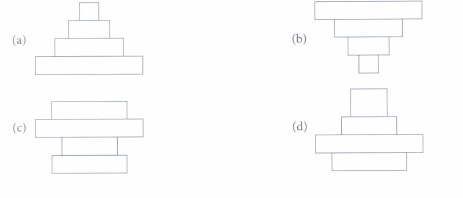 (a)
(a)
Case Study
*****************************************
Answers
Our Environment Case Study Questions With Answer Key Answer Keys
-
(i) (a) :According to the given graph, P is a waste that is not decomposed with the time. Hence, it can be a non-biodegradable waste such as glass and plastic wastes, synthetic polymers, pesticides, etc. Q took sometime for decomposing, hence it can be a waste made up of biodegradable material such as leather bag. As R starts decomposing in a very short span of time, this means it is a biodegradable waste such as fruit peel, cow dung, human excreta, etc.
(ii) (d): Increased use of plastic material in packaging has resulted in generation of lot of solid wastes. Dumping industrial chemical waste affects the soil fertility and subsequently reduces crop yield. Solid waste can block drains creating pools of water which can become breeding ground for mosquitoes and therefore, could increase the incidents of disease in the locality.
(iii) (a)
(iv) (c) : Used syringes and needles should not be reused as they may be contaminated. They must be burned at high temperature inside a closed chamber to prevent cross contamination.
(v) (c) : Both substances X and Y decompose so they both are biodegradable materials. Substance Z does not decompose at all. Hence, it could be a non-biodegradable material. -
(i) (b): Since a food chain is a sequential flow of food energy, it does not add to the adaptability and competitiveness of the organism.
(ii) (a) : In the given food chain, A is a primary consumer that feeds on grass and being eaten by frog. Therefore, among the given organisms, A should be grasshopper.
(iii) (c)
(iv) (d)
(v) (a): In a food chain, there is repeated eating in which each group eats the smaller one and is eaten by the larger one. -
(i) (c) : In the given food web, water fleas feed on insect larvae and are in turn fed by water beetles. So, if water fleas get eliminated then population of insect larvae will increase and that of water beetles will decrease. As small fish are dependent on water beetles for food, a decrease in population of water fleas will cause a decrease in their population as well. Population of frogs remain unaffected as frog also depend upon insect larvae for food.
(ii) (a) : Small fish operates at both primary and tertiary consumer level in the given food web
Aquatic plant \(\longrightarrow\)Small fish\(\longrightarrow\)Large fish
Aquatic plant \(\longrightarrow\) Insect larvae \(\longrightarrow\)Water fleas\(\longrightarrow\)Small fish\(\longrightarrow\)Large fishes
(iii) (c)
(iv) (d)
(v) (b): Food webs make a natural ecosystem stable than a man-made ecosystem. -
(i) (a): Due to bio-magnification, the concentration of DDT will always be less in zooplanktons than large fish
(ii) (c)
(iii) (b) : Due to bio-magnification the non bio-degradable chemicals such as DDT accumulate and go on concentrating at each trophic level.
(iv) (d) : Higher amounts of DDT disturb calcium metabolism of birds resulting in thinning of egg shells and their premature breaking that kills the embryos.
(v) (d) -
(i) (c) : Ozone is present in the stratosphere of the earth's atmosphere between 20 to 26 km above sea level.
(ii) (d)
(iii) (a) : Ozone hole was first discovered over Antarctica in 1985. Ozone absorbs UV-radiations in the range 2000-2900A.
(iv) (d) : The substances that depletes the ozone layer are called ozone depleting substances (ODS). The main ODS are chlorofluorocarbons, halons, methane, nitrous oxide, carbon tetrachloride and chlorine.
(v) (b) -
(i) (a) : Producers contain maximum energy and as energy passes onto higher trophic level along with food, its amount decreases. Hence P has maximum energy while S has least.
(ii) (a): Pyramid of biomass in a grassland ecosystem is upright.
(iii) (a) : Pyramid of number in a tree ecosystem is spindle shaped.
(iv) (c)
(v) (b): The available energy is highest at the producer level and there is gradual decrease in available energy at successive trophic level.
-
(i) (b) :In the given pie chart, gases P, Q, Rand S respectively are CO2 , CH4 , CFCs and N2O. Methane is produced by incomplete combustion of biomass.
(ii) (c): Methane (gas Q) is produced by incomplete biomass combustion and incomplete decomposition mostly by anaerobic methanogens. Flooded paddy fields, marshes and cattles are the major source of this gas.
(iii) (c) : CO2 is the principal greenhouse gas that helps to keep the earth warm.
(iv) (d)
(v) (c) -
(i) (c)
(ii) (a) : Incineration is the process of burning substances at high temperature usually at about 1000°C.
(iii) (b)
(iv) (b) : Pyrolysis involves anaerobic destructive distillation of the combustible constituents of the solid wastes at high temperature so as to recover the chemical constituents and chemical energy of organic wastes.
(v) (b) -
(i) (b) : As population of X is declining constantly, it is most unlikely to be alive in next 10 years.
(ii) (b) : When population W appears in the area, there is decline in population of X and Y but as X is continuously decreasing and W becomes somewhat constant, this implies that W is not feeding on X. On the other hand as population of Y is becoming constant, population W also shows constant numbers. This shows that species W is likely to feed on species Y.
(iii) (c)
(iv) (c): As the population of Z is nearly constant, this may due to the nearly equal ratio of death and birth rate.
(v) (d) -
(i) (c) : The sun is the primary source of energy for almost all ecosystems. Sunlight is converted to chemical energy during photosynthesis by the oak tree.
(ii) (d): A total of 14 food chains are operating in the given food web.
(iii) (c) : A new predator of skunks would result in the fall of its population and thus corresponding rise in the population of toad since less would be preyed upon. A predator of skunk is unlikely to be the prey of toad.
(iv) (d) : The oak tree is the producer, thus the most energy passes through the oak compared to other organisms. By the time energy reaches the higher trophic levels, significant energy would have been lost between trophic levels.
(v) (c) -
(i) (b): 1% of solar radiation is captured by plants. Sun is the ultimate source of all energy.
(ii) (d)
(iii) (d)
(iv) (d): The given pyramid is pyramid of energy that shows the two basic laws of thermodynamics.
(v) (c): Light energy from the sun is converted to chemical energy in producers via photosynthesis. This chemical energy is then transferred to primary consumer, then subsequently to secondary consumer via feeding. -
(i) (d)
(ii) (b): Artificial ecosystems are maintained by man and hence are also termed as man-made or man engineered ecosystems. In these ecosystems, man maintains/ disturbs the natural balance by the addition of energy and planned manipulations. Common examples of artificial ecosystems are croplands, orchards, gardens, aquarium, etc.
(iii) (c): Fungi and bacteria are decomposers which serve to convert carbon locked up in dead organic matter into carbon dioxide, which can then be utilised by plants during photosynthesis. A Band D are incorrect since decomposers do not increases the amount of nutrients, energy and carbon dioxide in the ecosystem. They merely allow cycling of nutrients, including carbon, to occur.
(iv) (a)
(v) (d): Primary or first-order consumers include the animals which eat plants or plant products. They are called herbivores. As the herbivores feed on plants/plant products and convert them into animal matter, they are often called key industry animals. Inorganic substances, e.g., carbon, nitrogen, oxygen, calcium, phosphorus, etc. and their compounds (water, carbon dioxide, etc.) constitute the main abiotic components. These occur either in the form of compounds dissolved in water, in the soil or in free state in the air. -
(i) (a): Decomposers work at every trophic level in a food chain as they feed on both producers and consumers.
(ii) (c)
(iii) (d) : In an ecosystem, trophic levels are formed by organisms linked in a food chain. The organisms deriving their energy from the same source belong to the same trophic level.
(iv) (a) : The quantum of available energy in a food chain successively gets decreased at each trophic level as a result of waste of energy in the form of heat. Second law of thermodynamics says that transformation of energy from one form to the other is inefficient and involves dissipation of unavailable energy. This phenomenon (loss of energy at successive trophic levels) restricts the size of food chain in an ecosystem to maximum of 4 or 5 steps or trophic levels.
(v) (a): Correct order of the food chain is
Grass - Worms - Sparrow - Eagle
T1 T2 T3 T4 -
(i) (c) : Air of city 2 is most polluted as maximum amount of oxides of sulphur and nitrogen are present in its atmospheric air.
(ii) (c): When the rain water contains large quantities of acids like nitric acid and sulphuric acid formed by dissolution of oxides of nitrogen and sulphur in water it is called acid rain.
(iii) (a) : Term acid rain was coined by Robert Angus in 1872.
(iv) (d)
(v) (d) : Acid rain consists 60-70% of oxides of sulphur (e.g., SO2 and SO3) and 30-40% of oxides of nitrogen (e.g., NO2 and NO3) Oxides of nitrogen are produced due to combustion process of fossil fuels at high temperatures in industries, automobiles, nitrogen fertiliser while oxides of sulphur are mainly produced due to burning of coal, ore-smelters and oil refineries. The main sources of oxides of sulphur are volcanoes (67%), industries (22%), vehicles and forest fires. -
(i) (a)
(ii) (b): Tiger is a secondary consumer in food chain B and tertiary consumer in food chain D.
(iii) (a) : Top consumer of food chain A will have maximum energy as it is the shortest food chain.
(iv) (d) : In food chain D, wild cat is the secondary consumer. Therefore, according to 10% law, amount of energy present in secondary consumer will be 200 KJ
(v) (b): Food chain E belong to aquatic ecosystem. Therefore, its pyramid of biomass will be inverted. Grazing food chains are directly dependent upon solar radiations as the primary source of energy. Green plants (or producers) form the first trophic level of the food chain. They synthesise their food by the process of photosynthesis. Herbivores or primary consumers feed upon the producers and form the second trophic level.
Case Study

























